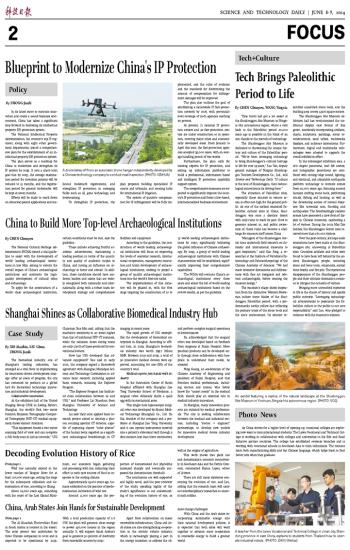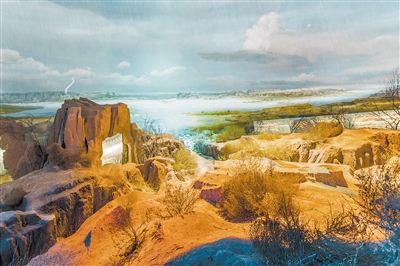
 Blueprint to Modernize China's IP Protection
Blueprint to Modernize China's IP Protection Tech Brings Paleolithic Period to Life
Tech Brings Paleolithic Period to Life China to Build More Top-level Archaeological Institutions
China to Build More Top-level Archaeological Institutions Shanghai Shines as Collaborative Biomedical Industry Hub
Shanghai Shines as Collaborative Biomedical Industry Hub Photo News
Photo News Decoding Evolution History of Rice
Decoding Evolution History of Rice China, Arab States Join Hands for Sustainable Development
China, Arab States Join Hands for Sustainable Development
 |
| An exhibit featuring a replica of the natural landscape at the Shuidonggou Site Museum in Yinchuan, Ningxia Hui autonomous region. (PHOTO: VCG) |
Time travel just got a lot easier at the Shuidonggou Site Museum in Ningxia Hui autonomous region, where a visit back to the Paleolithic period 40,000 years ago is possible in the blink of an eye, thanks to the marvels of technology.
The Shuidonggou Site Museum is dedicated to showcasing the unique history and culture of the Paleolithic period. "We've been leveraging technology to bring Shuidonggou's cultural heritage to life for over 13 years," Luo Yan, deputy general manager of Ningxia Shuidonggou Tourism Development Co., Ltd., told Science and Technology Daily. "If culture is the soul of Shuidonggou, then technological innovation is its driving force."
The attraction of Paleolithic sites, especially those situated in remote areas, is often not high for the general public. As one of the earliest excavated Paleolithic cultural sites in China, Shuidonggou was once a desolate desert with only ruins to mark its past. How to generate interest in, and public awareness of, these ruins has become a challenge for museum staff across China.
"Managers of the Shuidonggou Scenic Area undertook field research on domestic and international museums to gain inspiration," said Gao Xing, a researcher at the Institute of Vertebrate Paleontology and Paleoanthropology of the Chinese Academy of Sciences. "We had made extensive discussions and deliberations with fine art designers and relevant archaeologists, before creating the museum design."
The museum's shape draws inspiration from the distinctive Western Mosterian culture stone blades of the Shuidonggou Paleolithic period, with a predominantly earthy yellow hue reflecting the primary tones of the stone tools and the site's environment. Its exterior resembles unearthed stone tools, and the building area covers 4,308 square meters.
The Shuidonggou Site Museum exhibition hall has revolutionized the traditional display case format of this genre, seamlessly incorporating artifacts, charts, sculptures, paintings, scene reconstructions, sand tables, multimedia displays, and audience interactions. Furthermore, digital and multimedia technologies were adopted to upgrade the overall exhibition effect.
In the submerged exhibition area, a 270-degree panorama, real-life scenes, and holographic projections are combined with cutting-edge sound, lighting, and electrical, and adjustable earthquake platform technology to recreate scenes from 40,000 years ago, featuring ancient humans crafting stone tools, performing rituals, fishing and hunting, as well as the devastating scenes of natural disasters like torrential rain, flooding and earthquakes. The breathtakingly realistic scenes have pioneered a new form of display in Chinese museums, captivating a lot of visitors. During the 2024 May Day holiday, the Shuidonggou Scenic Area received more than 160,000 visitors.
Over the past century, six large-scale excavations have been made at the Shuidonggou site, uncovering 12 Paleolithic sites. Countless artifacts and relics were found to have been left behind by the ancient Shuidonggou people, including stone and bone tools, ornaments, animal bone fossils, and fire pits. The mysterious disappearance of the Shuidonggou people and their ultimate destination continue to intrigue the curiosity of visitors.
Bringing more unresolved mysteries to life is the charm of history and sparks public curiosity. "Leveraging technological advancements to popularize the Paleolithic culture to the public is our core responsibility," said Luo, who pledged to continue with the museum's mission.


 Next
Next



